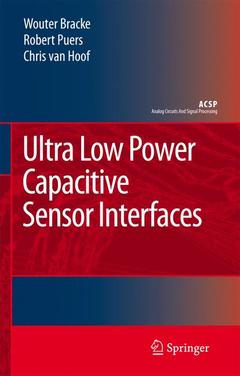Description
Ultra Low Power Capacitive Sensor Interfaces, Softcover reprint of hardcover 1st ed. 2007
Analog Circuits and Signal Processing Series
Authors: Bracke Wouter, Puers Robert, Van Hoof Chris
Language: English
Subject for Ultra Low Power Capacitive Sensor Interfaces:
105.49 €
In Print (Delivery period: 15 days).
Add to cart
Ultra Low Power Capacitive Sensor Interfaces
Publication date: 11-2010
104 p. · 15.5x23.5 cm · Paperback
Publication date: 11-2010
104 p. · 15.5x23.5 cm · Paperback
105.49 €
Subject to availability at the publisher.
Add to cart
Ultra low power capacitive sensor interfaces (Analog circuits & signal processing) POD
Publication date: 07-2007
Support: Print on demand
Publication date: 07-2007
Support: Print on demand
Description
/li>Contents
/li>Comment
/li>
The increasing performance of smart microsystems merging sensors, signal processing and wireless communication promises to have a pervasive impact during the coming decade. These autonomous microsystems nd applications in sport evaluation, health care, environmental monitoring and automotive s- tems. They gather data from the physical world, convert them to electrical form, compensate for interfering variables or non-linearities, and either act - rectly on them or transfer it to other systems. Most often, these sensor systems are developed for a speci c application. This approach leads to a high rec- rent design cost. A generic front-end architecture, where only the sensors and the microcontroller software are customized to the selected application, would reduce the costs signi cantly. This work presents a new generic architecture for autonomous sensor nodes. The modular design methodology provides a exible way to build a complete sensor interface out of con gurable blocks. The settings of these blocks can be optimized according to the varying needs of the application. Furthermore, the system can easily be expanded with new building blocks. The modular system is illustrated in a Generic Sensor Interface Chip (GSIC) for capa- tive sensors. Many con guration settings adapt the interface to a broad range of applications. The GSIC is optimized for ultra low power consumption. It achieves an ON-state current consumption of 40?A.
Generic architectures for autonomous sensors.- Generic Sensor Interface Chip.- Algorithm for optimal configuration settings.- Physical Activity Monitoring System.- Conclusion.
Low power sensor interface How to desing to obtain maximal flexiblity for the sensor specifications (generic) Capacitive sensor interface with wide range capabiliies
© 2024 LAVOISIER S.A.S.




